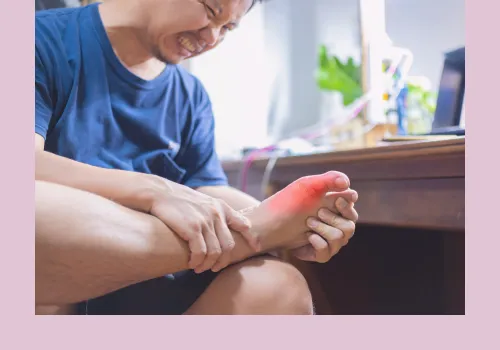Big Toe Pain | When Stiffness Strikes Your Big Toe
Introduction
This article focuses on a common yet often overlooked problem: big toe arthritis Rigidus).
Whether you're an active runner, a dedicated dancer, a hardworking teacher, or someone who loves a good round of golf, the health of your feet is crucial to your daily life and overall well-being. Big toe arthritis can significantly impact your mobility and quality of life, making simple activities like walking or standing painful and challenging. In this post, we'll help you understand the symptoms, diagnostic procedures, and steps to getting a diagnosis so you can take the first step towards relief.
Symptoms and Indications
Big toe arthritis, or hallux rigidus, manifests through symptoms ranging from mild discomfort to debilitating pain. Understanding these symptoms is essential for recognizing when you might need professional help.
Common Symptoms
- Pain and Stiffness: Persistent pain and stiffness in the big toe, especially during movement or after resting, are primary indicators of arthritis.
- Swelling and Inflammation: Swelling around the joint, accompanied by redness and warmth, suggests inflammation.
- Reduced Range of Motion: Difficulty bending or moving the big toe, making walking or running uncomfortable.
- Bone Spurs: The formation of bony growths around the affected joint, which may create a noticeable bump.
- Pain in Other Parts of the Foot: Sometimes, to compensate for the pain in your big toe, you might alter the way you walk - your gait, causing discomfort in other parts of your foot or even your knees and hips.
Subtle Signs
- Altered Gait: A change in walking style can be a subtle sign that you are trying to avoid pain in your big toe.
- Footwear Issues: Difficulty finding comfortable shoes or wearing out certain parts of your shoes faster than others.
- Intermittent Pain: Occasional sharp pain triggered by specific activities or prolonged periods of inactivity.
Recognising these symptoms early can lead to a timely diagnosis and more effective treatment options.

Diagnostic Procedures
Once you've identified potential symptoms of big toe arthritis, the next step is to undergo diagnostic tests. These procedures help healthcare professionals accurately diagnose the condition and determine its severity.
Physical Examination
A thorough physical exam by a podiatrist or orthopaedic specialist is the first step. During the examination, the doctor will:
- Assess your range of motion and flexibility.
- Evaluate swelling, tenderness, and any deformities.
- Observe your gait and how you distribute weight on your feet.
Imaging Tests
- X-raysX-rays provide a detailed look at the bone structure and can reveal joint space narrowing, bone spurs, and other arthritis-related changes.
- MRI (Magnetic Resonance Imaging): MRI scans offer comprehensive images of both bone and soft tissues, helping to detect any cartilage damage or inflammation that X-rays might miss.
- CT Scan (Computed Tomography): While less common, CT scans can provide a three-dimensional view of the affected area, offering more detail than standard X-rays.
Laboratory Tests
In some cases, blood tests may be conducted to rule out other types of arthritis, such as rheumatoid arthritis, which can present similar symptoms.
Getting a Diagnosis
Diagnosingspecialising big toe arthritis involves more than just identifying symptoms; it requires professional assessment and support. Here’s how to navigate the process:
Seek Professional Assistance
- Consult a Specialist: Schedule an appointment with a podiatrist, orthopaedic surgeon, or rheumatologist specialising orthopaedic in foot conditions.
- Prepare for Your Visit: Document your symptoms, pain levels, and any activities that exacerbate your condition. Bring a list of medications and previous medical records if applicable.
During the Appointment
- Discuss Your Symptoms: Be honest and detailed about your discomfort and how it affects your daily life.
- Ask Questions: Don’t hesitate to ask questions about the diagnostic procedures, potential treatments, and what to expect moving forward.
- Follow-up Plan: Understand the next steps, whether it's further testing, starting a treatment plan, or scheduling a follow-up visit.
Support and Understanding
Receiving a diagnosis can be overwhelming, but it’s also the first step towards effective treatment. Remember that you’re not alone; support groups, online communities, and healthcare providers can offer guidance and reassurance.
In Summary
Big toe arthritis can significantly hinder daily activities and diminish overall quality of life.
By understanding the symptoms, undergoing appropriate diagnostic procedures, and seeking professional assistance, you can take control of your condition and work towards relief and recovery.
If you believe you may be experiencing symptoms of big toe arthritis, Foot-Doctor is here to develop a personalised management plan.
Early diagnosis and intervention are key to managing arthritis and maintaining an active, fulfilling lifestyle.
To learn more about how Foot-Doctor can help, click below to take your assessment.
